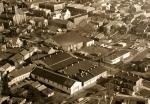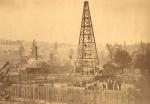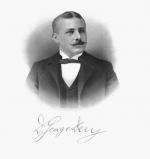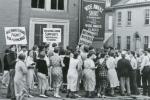Chapter 2: Natural and Human Resources
The wealth and industry of Pennsylvania were derived initially from the natural resources of the colony. The people who were attracted to the region to work in industry would also become a significant resource. With its good soil and temperate climate, Pennsylvania proved well-suited for European-style agriculture. The extensive forests the settlers found represented both an impediment to farming and a valuable energy source and building material.
It did not take colonists long to begin to use innovative technology in the form of an improved axe and sawmills to cut and process trees. The hilly terrain and abundant rainfall of Pennsylvania created a large number of fast-flowing streams that could be used to power mills of all kinds, especially colonial grist mills that soon dotted the countryside. A particularly important use of water power was to blow air through blast furnaces containing a mixture of iron ore, charcoal, and limestone to make iron. Because of the abundance of these materials–charcoal was a forest product, after all–Pennsylvania became the center of the colonial iron industry. Iron making and working already had the characteristics of a modern industry, employing complex technology and requiring large amounts of capital.
colonial grist mills that soon dotted the countryside. A particularly important use of water power was to blow air through blast furnaces containing a mixture of iron ore, charcoal, and limestone to make iron. Because of the abundance of these materials–charcoal was a forest product, after all–Pennsylvania became the center of the colonial iron industry. Iron making and working already had the characteristics of a modern industry, employing complex technology and requiring large amounts of capital.
Another Pennsylvania colonial enterprise that was "industrial" in nature was shipbuilding. An abundance of wood, combined with ports on the Delaware and Ohio Rivers and Lake Erie, made Pennsylvania a boatbuilding center. In the Pittsburgh area after 1810, Henry Shreve designed and built innovative steamboats that would make upstream travel possible on the Mississippi and Ohio Rivers. Philadelphia would long be a leading shipbuilding city, but Pittsburgh also specialized in river transport. The
a boatbuilding center. In the Pittsburgh area after 1810, Henry Shreve designed and built innovative steamboats that would make upstream travel possible on the Mississippi and Ohio Rivers. Philadelphia would long be a leading shipbuilding city, but Pittsburgh also specialized in river transport. The  Dravo brothers in the 1890s began selling heavy machinery but soon expanded into waterway projects and boatbuilding. The Pennsylvania boat industry made major contributions in both World War I and II. For example in World War II Dravo specialized in assembly-line production of ships, especially landing craft.
Dravo brothers in the 1890s began selling heavy machinery but soon expanded into waterway projects and boatbuilding. The Pennsylvania boat industry made major contributions in both World War I and II. For example in World War II Dravo specialized in assembly-line production of ships, especially landing craft.
In the mid-nineteenth century, improved transportation on rivers, canals, and railroads allowed entrepreneurs, such as Peter Herdic, to make Williamsport the lumber capital of the nation. In the decades after the Civil War, Pennsylvania produced more lumber than any other state. Wood was a raw material for other industries, important non-building uses included furniture, cigar boxes, packing boxes and crates, and carriages and wagons. The firms that made these products tended to be small ones that served local markets. One example was a carriage and wagon company founded by
Peter Herdic, to make Williamsport the lumber capital of the nation. In the decades after the Civil War, Pennsylvania produced more lumber than any other state. Wood was a raw material for other industries, important non-building uses included furniture, cigar boxes, packing boxes and crates, and carriages and wagons. The firms that made these products tended to be small ones that served local markets. One example was a carriage and wagon company founded by  Jeremiah Sweinhart in Doylestown in 1872. The company employed local men skilled in woodworking and blacksmithing. The re-named Doylestown Carriage Works thrived until cars, especially the Ford Model T and trucks, such as
Jeremiah Sweinhart in Doylestown in 1872. The company employed local men skilled in woodworking and blacksmithing. The re-named Doylestown Carriage Works thrived until cars, especially the Ford Model T and trucks, such as  Mack, proliferated in America after 1910. The company, however, survived by using its skills to make car and truck bodies, which were made principally of wood until the 1920s.
Mack, proliferated in America after 1910. The company, however, survived by using its skills to make car and truck bodies, which were made principally of wood until the 1920s.
In addition to trees, mineral resources contributed mightily to the industrial development of the Keystone State. Mining and metallurgy had long been practiced in Europe and were strategic industries both economically and militarily. Knowledge of ores and other minerals had advanced to the point that American colonials could prospect for valuable materials. The iron industry relied on relatively abundant deposits of iron ore and limestone. In the late eighteenth century, explorers discovered anthracite coal outcrops in the mountains of northeastern Pennsylvania. After the construction of canals and later railroads, the coal industry would become one of the state's largest and would fuel other industries, especially iron and steel.
A number of other mineral and energy resources led to the formation of important industries in Pennsylvania. In the 1830s, slate, used primarily for roof shingles, began to be quarried in a narrow belt south of the Blue Mountain between the Delaware and Lehigh Rivers. In subsequent decades this region, led by experienced Welsh slate workers, such as Robert M. Jones, became home to dozens of quarries, and it would become the country's major producer of slate.
slate, used primarily for roof shingles, began to be quarried in a narrow belt south of the Blue Mountain between the Delaware and Lehigh Rivers. In subsequent decades this region, led by experienced Welsh slate workers, such as Robert M. Jones, became home to dozens of quarries, and it would become the country's major producer of slate.
In the 1850s, zinc ores discovered in the Saucon Valley, just south of Bethlehem, were used by Joseph Wharton and Samuel Wetherill to make zinc oxide and metal at facilities on the Lehigh River in Bethlehem. After the turn of the twentieth century, a much larger plant emerged twenty miles upstream at Palmerton.
Samuel Wetherill to make zinc oxide and metal at facilities on the Lehigh River in Bethlehem. After the turn of the twentieth century, a much larger plant emerged twenty miles upstream at Palmerton.
Also in the Lehigh Valley, in 1871, David O. Saylor discovered that some local limestone cement rocks could be used to make Portland cement, which as the time was being imported from Great Britain. Saylor and other entrepreneurs proceeded to make Pennsylvania the number one cement-producing state for more than half a century. During this period American contractors used large quantities of cement in building and bridge and highway construction.
Portland cement, which as the time was being imported from Great Britain. Saylor and other entrepreneurs proceeded to make Pennsylvania the number one cement-producing state for more than half a century. During this period American contractors used large quantities of cement in building and bridge and highway construction.
The American petroleum industry had its origin in northwestern Pennsylvania where Edwin Drake drilled the first oil well in 1859. In addition to being an important industry in its own right–until the coming of automobile kerosene for lighting was its major product–petroleum provided energy for other industries. Oil wells frequently produced large amounts of natural gas that had little value in an era before the construction of an extensive pipeline network. Capitalizing on the availability of cheap natural gas along the Allegheny River north of Pittsburgh, in the 1880s John Baptiste Ford built three large plants to make plate glass for the Pittsburgh Plate Glass Company, which came to be one of the two major firms in the field.
Pittsburgh Plate Glass Company, which came to be one of the two major firms in the field.
The rapid growth of Pennsylvania's mills and mines after 1880 attracted an increasing flow of immigrants from southern and eastern Europe. Because male workers in coal mines and steel mills often did not earn enough money to support their families, the wives and children of immigrants had to seek employment outside the home. The availability of this large supply of potentially low-wage labor attracted the attention of owners of silk mills in Paterson, New Jersey, who were frustrated by the high wages they were paying to skilled workers. Beginning in the 1880s, these mill owners began to relocate to eastern Pennsylvania and employed thousands of women and children in new plants, including the Dery Silk Mill in Allentown, in which machines made skilled workers less necessary.
Dery Silk Mill in Allentown, in which machines made skilled workers less necessary.
By the 1920s Pennsylvania produced one-third of the nation's silk textiles. When the industry began to decline in the 1930s, many former silk workers moved into the rapidly growing apparel industry. The International Ladies Garment Workers Union (ILGWU), which was very strong in New York City, sought to organize the state's women's apparel workers who labored long hours for low wages. To provide an educational and recreational retreat for its members, the IGLWU established Unity House in the Pocono Mountains after World War I. The textile and garment industries of Pennsylvania thrived until the 1950s when mills increasingly moved to the South or overseas, where even cheaper labor could be found.
Unity House in the Pocono Mountains after World War I. The textile and garment industries of Pennsylvania thrived until the 1950s when mills increasingly moved to the South or overseas, where even cheaper labor could be found.
Although natural and human resources were critical to the development of Pennsylvania, in the longer run, most resource-based industries proved to be unsustainable. Sometimes, resources were simply used up, but more frequently the ongoing development of international capitalism led businessmen to seek new lower-cost resources elsewhere. The same imperative that brought colonists to Pennsylvania in the eighteenth century and contributed to the state's subsequent development led extractive industries to look elsewhere in the twentieth century and brought deindustrialization and job loss to the Commonwealth.
It did not take colonists long to begin to use innovative technology in the form of an improved axe and sawmills to cut and process trees. The hilly terrain and abundant rainfall of Pennsylvania created a large number of fast-flowing streams that could be used to power mills of all kinds, especially
Another Pennsylvania colonial enterprise that was "industrial" in nature was shipbuilding. An abundance of wood, combined with ports on the Delaware and Ohio Rivers and Lake Erie, made Pennsylvania
In the mid-nineteenth century, improved transportation on rivers, canals, and railroads allowed entrepreneurs, such as
In addition to trees, mineral resources contributed mightily to the industrial development of the Keystone State. Mining and metallurgy had long been practiced in Europe and were strategic industries both economically and militarily. Knowledge of ores and other minerals had advanced to the point that American colonials could prospect for valuable materials. The iron industry relied on relatively abundant deposits of iron ore and limestone. In the late eighteenth century, explorers discovered anthracite coal outcrops in the mountains of northeastern Pennsylvania. After the construction of canals and later railroads, the coal industry would become one of the state's largest and would fuel other industries, especially iron and steel.
A number of other mineral and energy resources led to the formation of important industries in Pennsylvania. In the 1830s,
In the 1850s, zinc ores discovered in the Saucon Valley, just south of Bethlehem, were used by Joseph Wharton and
Also in the Lehigh Valley, in 1871, David O. Saylor discovered that some local limestone cement rocks could be used to make
The American petroleum industry had its origin in northwestern Pennsylvania where Edwin Drake drilled the first oil well in 1859. In addition to being an important industry in its own right–until the coming of automobile kerosene for lighting was its major product–petroleum provided energy for other industries. Oil wells frequently produced large amounts of natural gas that had little value in an era before the construction of an extensive pipeline network. Capitalizing on the availability of cheap natural gas along the Allegheny River north of Pittsburgh, in the 1880s John Baptiste Ford built three large plants to make plate glass for the
The rapid growth of Pennsylvania's mills and mines after 1880 attracted an increasing flow of immigrants from southern and eastern Europe. Because male workers in coal mines and steel mills often did not earn enough money to support their families, the wives and children of immigrants had to seek employment outside the home. The availability of this large supply of potentially low-wage labor attracted the attention of owners of silk mills in Paterson, New Jersey, who were frustrated by the high wages they were paying to skilled workers. Beginning in the 1880s, these mill owners began to relocate to eastern Pennsylvania and employed thousands of women and children in new plants, including the
By the 1920s Pennsylvania produced one-third of the nation's silk textiles. When the industry began to decline in the 1930s, many former silk workers moved into the rapidly growing apparel industry. The International Ladies Garment Workers Union (ILGWU), which was very strong in New York City, sought to organize the state's women's apparel workers who labored long hours for low wages. To provide an educational and recreational retreat for its members, the IGLWU established
Although natural and human resources were critical to the development of Pennsylvania, in the longer run, most resource-based industries proved to be unsustainable. Sometimes, resources were simply used up, but more frequently the ongoing development of international capitalism led businessmen to seek new lower-cost resources elsewhere. The same imperative that brought colonists to Pennsylvania in the eighteenth century and contributed to the state's subsequent development led extractive industries to look elsewhere in the twentieth century and brought deindustrialization and job loss to the Commonwealth.






















